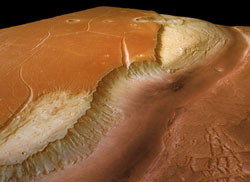Kasei Valles outflow channel system

This image, taken by the High Resolution Stereo Camera (HRSC) on board ESA's Mars Express spacecraft, shows the region of Kasei Valles, one of the biggest outflow channel systems on Mars. The HRSC obtained this image during orbit 1429 on 26 February 2005, at a ground resolution of approximately 29 metres per pixel. The image shows a perspective view of the Northern branch of Kasei Valles looking to the West (the image has been rotated approximately 90 degrees clockwise so that North is to the right). As one of the biggest outflow channel systems on Mars, Kasei Valles was probably formed by gigantic flood events and later additionally shaped by glacial activity. Credits: ESA/DLR/FU Berlin (G. Neukum)
The HRSC obtained these images during orbit 1429 at a ground resolution of approximately 29 metres per pixel.
The Kasei Valles region lies approximately between 21° and 28° North at 292.5° East.
Connecting the southern Echus Chasma and the plain Chryse Planitia in the East, Kasei Valles has a width of roughly 500 kilometres and, if Echus Chasma is included, extends for approximately 2500 kilometres.
There are two sets of images in this release, one showing the North branch, one showing the South branch. Both branches extend approximately South-West to North-East, and the images have been rotated one-quarter clockwise so that North is to the right.
Both valley branches exhibit a depth of 2900 metres.
As one of the biggest outflow channel systems on Mars, Kasei Valles was probably formed by gigantic flood events and later additionally shaped by glacial activity.
In the first set of images, the Northern branch of Kasei Valles and the plain Sacra Mensa can be seen. An oval structure at the western edge of the scene is interpreted to be a crater caused by an oblique meteorite impact.
The Southern branch of Kasei Valles and Sacra Mensa, with its 1- to 2-kilometre-deep graben system, Sacra Fossae, is shown in the second set of images. The terraces are up to 30 kilometres wide, located at the base of the walls on both sides of the valley branch.
The colour scene was derived from three HRSC-colour channels. The perspective views have been calculated from the digital terrain model derived from the stereo channels. The 3D anaglyph images were derived from the stereo and nadir channels. Image resolution has been decreased for use on the internet.
Media Contact
More Information:
http://www.esa.int/SPECIALS/Mars_Express/SEMH916LARE_0.htmlAll latest news from the category: Physics and Astronomy
This area deals with the fundamental laws and building blocks of nature and how they interact, the properties and the behavior of matter, and research into space and time and their structures.
innovations-report provides in-depth reports and articles on subjects such as astrophysics, laser technologies, nuclear, quantum, particle and solid-state physics, nanotechnologies, planetary research and findings (Mars, Venus) and developments related to the Hubble Telescope.
Newest articles

Sea slugs inspire highly stretchable biomedical sensor
USC Viterbi School of Engineering researcher Hangbo Zhao presents findings on highly stretchable and customizable microneedles for application in fields including neuroscience, tissue engineering, and wearable bioelectronics. The revolution in…

Twisting and binding matter waves with photons in a cavity
Precisely measuring the energy states of individual atoms has been a historical challenge for physicists due to atomic recoil. When an atom interacts with a photon, the atom “recoils” in…

Nanotubes, nanoparticles, and antibodies detect tiny amounts of fentanyl
New sensor is six orders of magnitude more sensitive than the next best thing. A research team at Pitt led by Alexander Star, a chemistry professor in the Kenneth P. Dietrich…





















